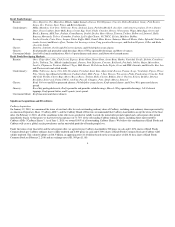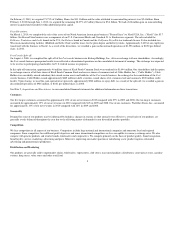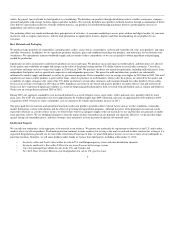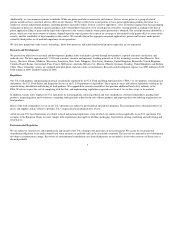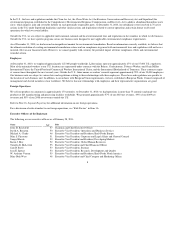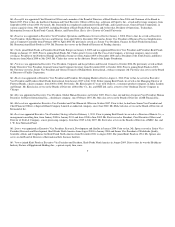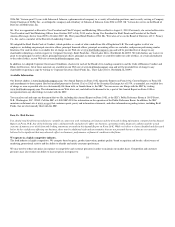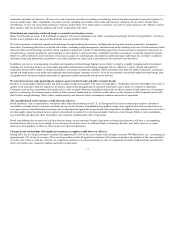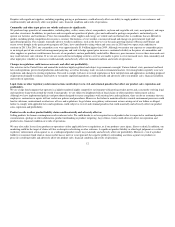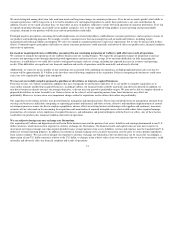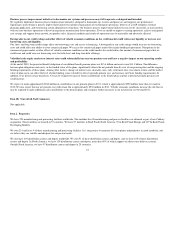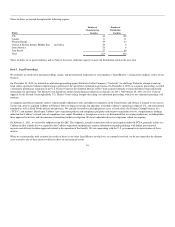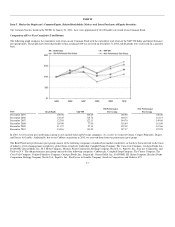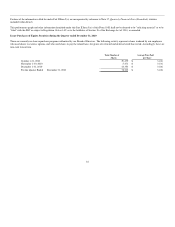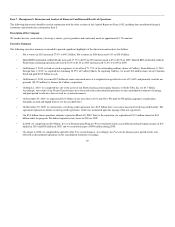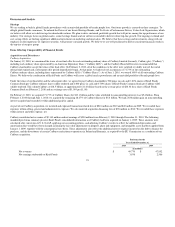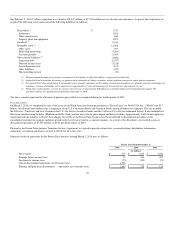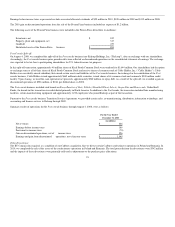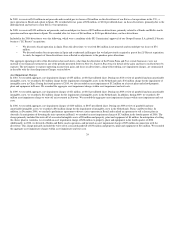Kraft 2010 Annual Report Download - page 17
Download and view the complete annual report
Please find page 17 of the 2010 Kraft annual report below. You can navigate through the pages in the report by either clicking on the pages listed below, or by using the keyword search tool below to find specific information within the annual report.
We must distinguish among short-term fads, mid-term trends and long-term changes in consumer preferences. If we do not accurately predict which shifts in
consumer preferences will be long-term, or if we fail to introduce new and improved products to satisfy those preferences, our sales could decline. In
addition, because of our varied consumer base, we must offer an array of products sufficient to satisfy the broad spectrum of consumer preferences. If we fail
to expand our product offerings successfully across product categories, or if we do not rapidly develop products in faster growing and more profitable
categories, demand for our products will decrease and our profitability could suffer.
Prolonged negative perceptions concerning the health implications of certain food products could influence consumer preferences and acceptance of some of
our products and marketing programs. For example, recently, consumers have been increasingly focused on health and wellness, including weight
management and reducing sodium consumption. We strive to respond to consumer preferences and social expectations, but we may be unsuccessful in these
efforts. Continued negative perceptions and failure to satisfy consumer preferences could materially and adversely affect our product sales, financial condition
and results of operations.
Increased or unanticipated costs or difficulties encountered in our continuing integration of Cadbury could affect our results of operations.
We continue to integrate the operations of our Cadbury business into our existing business. We expect the anticipated synergies of integration to increase
revenues and operating results through enhanced growth opportunities and increased cost savings. If we encounter difficulties in fully integrating the
businesses, it could delay or we could fail to achieve anticipated synergies and cost savings, including the expected increases in revenues and operating
results. If the difficulties are significant, our financial condition and results of operations could be materially and adversely affected.
Additionally, we expect to incur a number of non-recurring costs associated with combining our operations, including implementation cash costs that we
estimate will be approximately $1.5 billion in the first three years following completion of the acquisition. Delays in integrating the businesses could cause
such costs to be significantly higher than anticipated.
We may not successfully complete proposed acquisitions or divestitures or integrate acquired businesses.
From time to time, we evaluate acquisition candidates that may strategically fit our business objectives. If we are unable to complete acquisitions or to
successfully integrate and develop acquired businesses, including Cadbury, our financial results could be materially and adversely affected. In addition, we
may divest businesses that do not meet our strategic objectives, or do not meet our growth or profitability targets. We may not be able to complete desired or
proposed divestitures on terms favorable to us. Gains or losses on the sales of, or lost operating income from, those businesses may affect our
profitability. Moreover, we may incur asset impairment charges related to acquisitions or divestitures that reduce our profitability.
Our acquisition or divestiture activities may present financial, managerial and operational risks. Those risks include diversion of management attention from
existing core businesses, difficulties integrating or separating personnel and financial and other systems, effective and immediate implementation of control
environment processes across our diverse employee population, adverse effects on existing business relationships with suppliers and customers, inaccurate
estimates of fair value made in the accounting for acquisitions and amortization of acquired intangible assets which would reduce future reported earnings,
potential loss of customers or key employees of acquired businesses, and indemnities and potential disputes with the buyers or sellers. Any of these factors
could affect our product sales, financial condition and results of operations.
We are subject to foreign currency exchange rate fluctuations.
Our acquisition of Cadbury and disposition of our Frozen Pizza business increased the portion of our assets, liabilities and earnings denominated in non-U.S.
dollar currencies, which increased our exposure to currency exchange rate fluctuations. Our financial results and capital ratios are now more sensitive to
movements in foreign exchange rates than in prior periods because a larger portion of our assets, liabilities, revenue and expenses must be translated into U.S.
dollars for external reporting purposes. In addition, movements in foreign exchange rates can affect transaction costs because we source product ingredients
from various countries. We may seek to mitigate our exposure to currency exchange rate fluctuations, but our efforts may not be successful. Accordingly, a
depreciation of non-U.S. dollar currencies relative to the U.S. dollar, or changes in the relative value of any two currencies that we use for transactions, could
materially and adversely affect our financial condition and results of operations.
14


